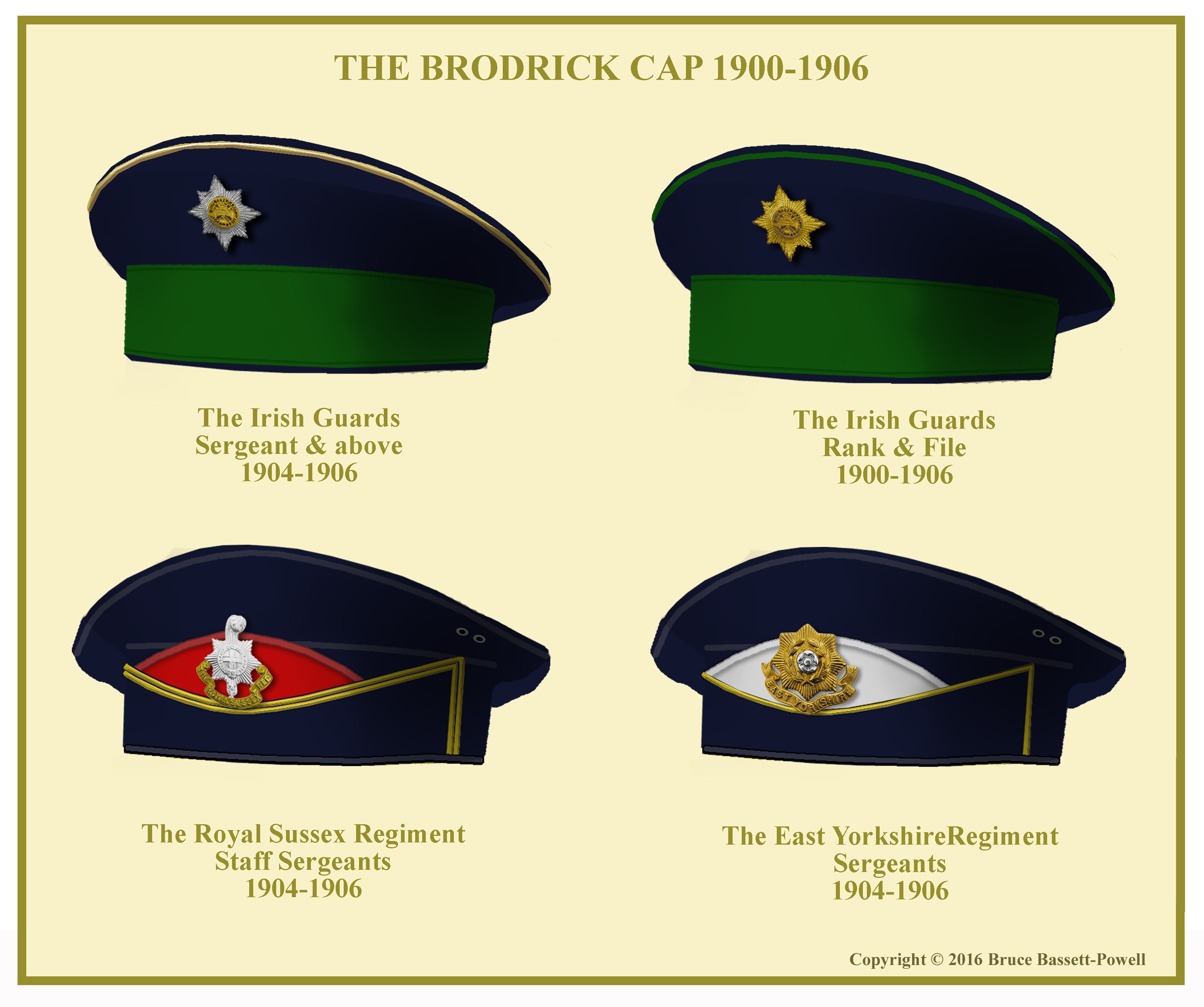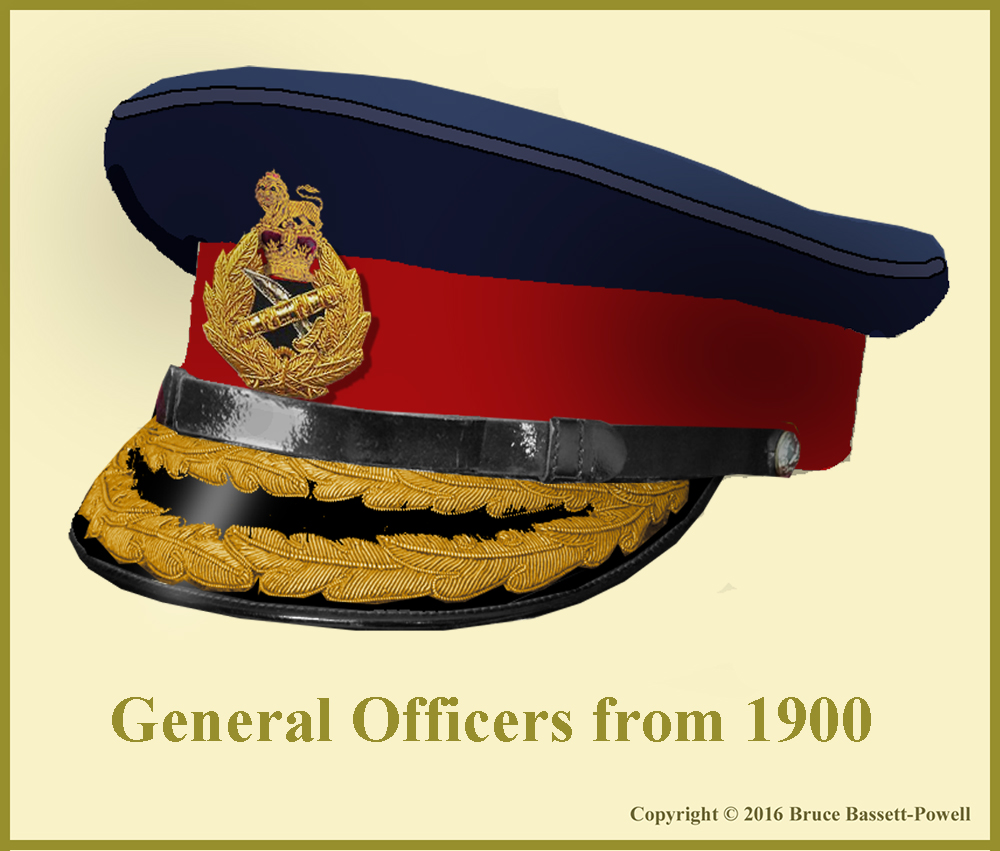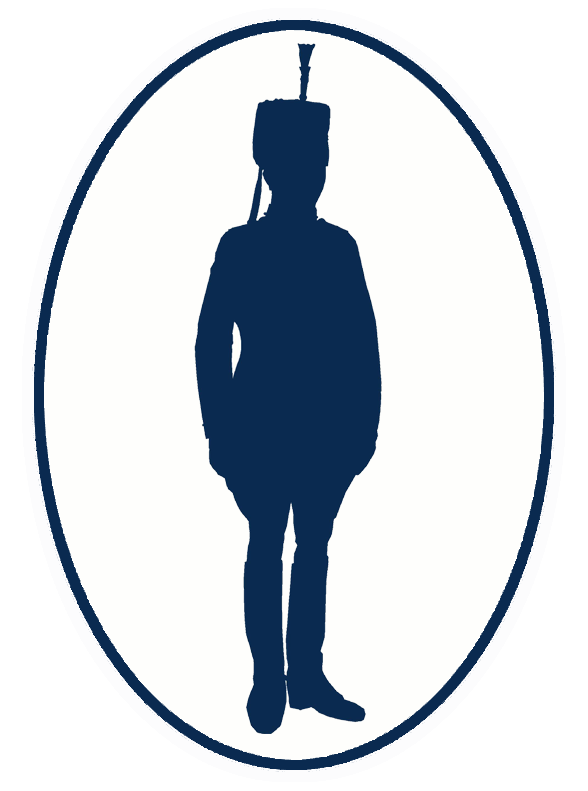PEAKED FORAGE CAPS AND BADGES IN THE BRITISH ARMY 1881-1902
PAGE 4
THE STAFF PATTERN FORAGE CAP
The cap worn by Field Marshalls and Generals had a patent leather peak with gold bullion oak-leaf lace round the whole peak, blue Melton cloth body and scarlet band. The badge of crossed baton and sword within a wreath and surmounted by the Crown all in gold embroidery was worn on the front. For Colonels on the Staff, the peak had the lace round the front edge only and the badge was the Royal Crest. For other staff officers, the peak had half-inch full embroidery on the peak.
THE BRODRICK CAP – THE FOOT GUARDS
In November 1900 the “NP Field Cap” (Later “NP Forage Cap”) was authorized for the Brigade of Guards. Although the Scots Guards were to be the first to receive it, the newly raised Irish Guards (illustrated) were the first to wear it. Briefly, the body of the cap was to be 2 inches wide and the circular crown of blue cloth to be 3 inches greater than the body. The removable cap band (except for the Scots Guards was of regimental colour – emerald green in the Irish Guards. The crown of the cap was also piped in regimental colour. Staff sergeants and sergeants wore a bi-metal badge while the rank and file had plain brass. In 1904 the same staff sergeants and sergeants were allowed gold cord piping around the crown.
THE BRODRICK CAP – THE LINE REGIMENTS
The cap worn by the rest of the army was quite different to that of the Guards. The first pattern (for Dragoon Guards and Dragoons) was sealed in July of 1902 and was dark blue throughout. The body had a dark blue concave flap stitched to the front. Behind that was a dark blue convex patch, which at first was also blue. Both the flap and patch had blue welts. The crown which was 2 ½” greater than the body also had a blue welt around the edge. In 1903, there was a change when more colour was added. In the infantry the patches were allowed to be of facing colour, which for “Royal” regiments was scarlet. In 1904, gold lace piping for staff sergeants and sergeants was allowed around the edges of the flap. Two rows for the staff and one row for sergeants as shown in the plate. A full listing of all the colours and edging in the various corps and branches of the army are not in the purview of this series.
The Brodrick lasted until 1906, when it was swiftly replaced by the peaked “Staff” pattern cap for all ranks in all branches. The Household cavalry had received this cap in late 1903 (without any badge) and some other cavalry regiments had managed to avoid wearing the Brodrick at all.
-------------------------------------------------------------
Thus concludes the story of the round forage cap, which although an undress item, had a certain elegance and was very popular with those that wore it. Most of the badges that adorned them did not survive and very few of them exist today which makes this presentation a source of much satisfaction. For the Warrant Officers and Staff Sergeants that wore the “Chinese Mandarin Cap”, (as it was jokingly called in the Guards), its replacement with the Brodrick Cap was a blow. As soldiers were allowed to wear uniform items until they were worn out, the wearing of the round forage cap went on far beyond the normal acceptancy. In fact, most Sergeant-Drummers are seen in photos with it firmly on their heads as late as 1905 and some may never have worn the Brodrick. While the cap was worn widely by the British home forces, it was also worn by most of the auxiliary forces of the Empire, especially in Canada, Australia, New Zealand, Southern Africa and India.
The British Army, with its unbroken existence since 1660, attaches itself to the symbols of its identity like no other army on earth. To this day, amalgamated regiments adorn themselves with insignia of regiments long forgotten by anyone but themselves and yet treasured beyond measure and worn with unabashed pride. The old, round forage caps and their badges, were never really forgotten because elements of every one of those badges can still be found on British soldiers’ caps or uniforms today.
-----------------------------------------------------
Bob Bennett and I have thoroughly enjoyed putting this series together and hope that our readers have also appreciated it. The research has been most rewarding as some of the details of these old badges were hard to find. We would not have been able to complete it without the assistance of many friends and associates and we acknowledge them here:
Julian Bowsher, Peter Brydon, Stuart Bates, Ray Westlake, Gary Gibbs, John Young, John Mulcahy, Samantha Harris and Steve Finnis of the Maidstone Museum’s exhibit of the Queen’s Own Royal West Kent Regiment, Norman Wood for the Channel Islands Militia badges and Denis Darmanin for the Royal Malta Militia badges.
Additional Bibliography.
Chichester, Henry & Burges-Short, George. Records and Badges of the British Army, 1900
Farmer, J.S. Regimental Records of the British Army 1660-1901.
Kipling, Arthur & King, Hugh, Headdress Badges of the British Army
Perry, Ottley Lane. Rank and Badges in Her Majesty’s Army and Navy, 1888
War Office, Dress Regulations for the Army 1883, 1891 and 1900
CONCLUSION
In 1900 the illustrated Dress Regulations specified the new Staff Pattern Forage Cap, which in general appearance, remains today the style of cap, both dress and undress worn by officers and men alike, of the British and most other armies of the world. At first these were to be worn by the most senior officers of the staff and departments of the army, replacing the round forage cap with gold lace band. By 1902 they were authorized for all officers and Warrant Officers of the army while the other ranks were to adopt a cap approved by the current Secretary of State for War, Mr. St. John Brodrick. This cap, resembling (depending on the bias of the observer) the seaman’s cap, the German undress cap or the Russian undress cap, was not popular, especially for the staff sergeants of the infantry battalions and corps with which the round forage cap was most associated. The rank and file was probably less concerned as, like soldiers everywhere, they wore what they were issued with a large amount of stoicism.




